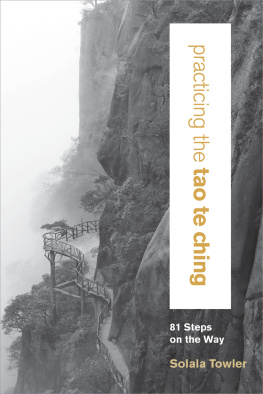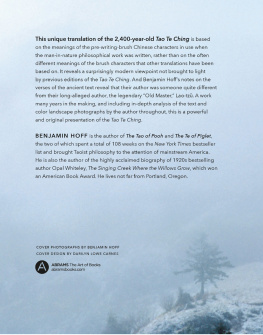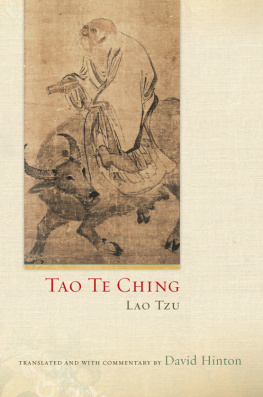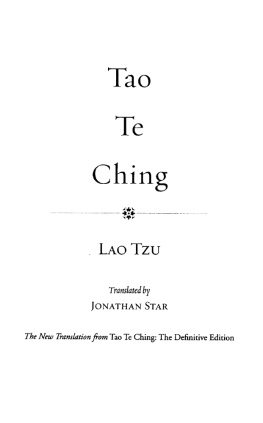Everyday Tao Te Ching
A Renegades Practical Guide to Happiness Today
Copyright 2013 by Pat OBryan. All rights reserved.
ISBN: 978-0-9896469-1-8
Published by Portable Empire Publishing, Terlingua, Texas
For more information, or to learn how you can publish your book, visit www.PortableEmpirePublishing.com
Companion website at www.EveryDayTaoTeChing.com
Cover Image: X-ray Nautilus , Bert Myer s . bmyersphoto.com
Author photo: Betsy Blaydes
Edited by Craig Burdett
No part of this publication may be reproduced, stored in a retrieval system, or transmitted in any form or by any means, electronic, mechanical, photocopying, recording, scanning, or otherwise, except as permitted under Section 107 or 108 of the 1976 United Stated Copyright Act, without the prior written permission of the publisher or copyright holder. Requests should be addressed to Portable Empire Publishing, PO Box 316, Terlingua, TX 79852.
Limit of Liability/Disclaimer of Warranty: The publisher, designers, contributors, editors, and author have used their best efforts in preparing this book. They make no warranties or representations with respect to the accuracy or completeness of the contents of this book and specifically disclaim any implied warranties of merchantability or fitness for a particular purpose. It is further acknowledged that no warranty of any kind may be created or extended by any written sales materials or sales representatives. The advice and strategies contained herein may not be suitable for your situation and do contain risk including the risk of financial loss. You should always consult with a financial or legal professional where appropriate before undertaking any action and users of this material assume all risk. Neither the publisher, designers, editors, contributors nor the author shall be liable for any loss of profit or any other commercial damages, including but not limited to financial, special, incidental, consequential, or other damages.
Everyday Tao Te Ching
A Renegades Practical Guide to Happiness Today
The Tao for The Rest of Us
Pat OBryan
Foreword
Most interpretations and translations of the Tao are either written in archaic language or are very direct translations from the original Chinese. And, since the Tao was written for kings and princes, most versions mirror the original high-brow intent.
Reading these modern translations I find my mind retranslating them into todays casual English. I conduct mental gymnastics to adapt cautions for kings into something I can use. Here. Today. And its distracting and tiring.
So I started rewriting the Taofor myself. Why?
The Tao works!
Thats why.
Ive been studying the Tao, off and on, since 1975. And, for the better part of 40 years, I keep coming back to the Tao because, when I remember to use it, my life is better. Im happier. Its easier to stay in the moment.
As I mentioned, I originally began writing this for myself. I wanted a simple and straight-forward version of the Tao. I wanted it to sound like somebody talking directly to me.
I wanted a version I could read and understand without wearing my brain out.
Thats not to say that reading the Tao is a mindless exercise. Its important to reflect and consider the world within us and around us as we read. But, hopefully, when you read this version, you wont have to do mental back-flips.
Chapter Zero
In The Tao of Zen Ray Grigg says Zen is Taoism dressed up as Buddhism. If you turn that sideways, then Taoism is Zen stripped of Buddhism.
The collision happened a long time ago, but heres the story.
Bodhidharma was an Indian Buddhist monk who lived during the 5th6th century CE. He is traditionally credited as the transmitter of Chn (Sanskrit: Dhyna, Japanese: Zen) to China, and regarded as its first Chinese patriarch.
When he left India, he was carrying a fairly traditional brand of Buddhism. When he got to China, he encountered the (well established) philosophy of Taoism. As the new Buddhism collided with the old Taoism, a new philosophy was formed. We know it as Zen.
Time passed. People are what people are. Over time, Taoism and Buddhism acquired the trappings of religion: ghosts, gods, fables, and rituals.
Luckily, we can peer through the mists of time to the origins of Taoism.
In typical Taoist fashion, the father of Tao philosophy either was or wasnt a gentleman named Lao Tsu. Lao Tsu means old fellow. And he lived in the 6 th century BCE or the 5 th century BCE. Or maybe the 4 th . Heres how Wikipedia puts it:
According to Chinese traditions, Lao Tsu lived in the 6th century BCE. Some historians contend that he actually lived in the 5th4th century BCE, concurrent with the Hundred Schools of Thought and Warring States Period, while some others argue that Laozi is a synthesis of multiple historical figures or that he is a mythical figure.
It doesnt matter. At this distance, it all looks the same. Well call the person (or persons) who wrote the Tao Te Ching, Lao Tsu.
And leave history to the historians.
The important thing is the book. Without the Tao Te Ching, and subsequent works based on it, we wouldnt have this amazing and powerful philosophy. Zen Buddhism wouldnt exist. And, Buddhism would probably not have penetrated so deeply into Western thoughtif it appeared at all outside India.
Alan Watts, D.T. Suzuki, Allan Ginsberg, Gary Snyder, Jack Kerouacthe early beacons of Buddhism in the West found their way to Buddhism through Zen. And, without Taoism, there would have been no Zen.
So, what is this amazing philosophy?
The Tao Te Ching is divided into 81 chapters. There is no apparent order to the chapters, except that the first chapter had to come first.
In studying the Tao, Ive noticed that the teachings can be categorized into eight lessons. Eight lessons is absolutely arbitrary, but by dividing the Tao into categories, patterns emerge from the apparently random chapters.
- Tao, the Watercourse Way
- Just Do Your Work and Move On
- Enough is E nough
- Wu weiMost of the time nothing is the right thing to do. Let it Be.
- ContrastNo right or wrong. Just different sides of the same thing.
- What Is
- Skillful Means
- The Power of Nothing
Tao for the Rest of Us is the Tao in 8 categories. These are the categories I came up with. I encourage you to make your own distinctions, create your own categories and come to your own conclusions.
Your understanding of the Tao will depend greatly on what you bring to it.
I think its a mistake to just read the Tao, nod wisely, and then put the book away. Dig in. Read a chapter and then restate it in your own words. Think about how the lesson in that chapter can be applied to your life.
I encourage you to read and compare other versions of the Tao. I assembled several versions and some companion texts at www.EveryDayTaoTeChing.com. Compare them side by side and come to your own conclusions.
The reason the Tao has lasted so long is because it is so practical. It works. Its not dependent on faith. You dont have to pretend to see things. If you get the lessons and apply them, your life really will be better. Youll be happier, and more successfulhowever you define success.
And, let me assure you, some of the earlier Tao practitioners would describe success in ways that have nothing to do with dressing for, or material possessions. Once you understand the Tao, your definition of success will probably change, too.
There really are no rules. The Tao offers practical guidelines, but its up to you to apply them to your life. You cant get it wrong as long as you do it.
Why I wrote this book.
In 1975, I was wandering around the auditorium at what was then North Texas State University with a copy of the course catalog and my registration forms. A music major, I had registered for all the music courses I was qualified to take, but needed one more elective.









